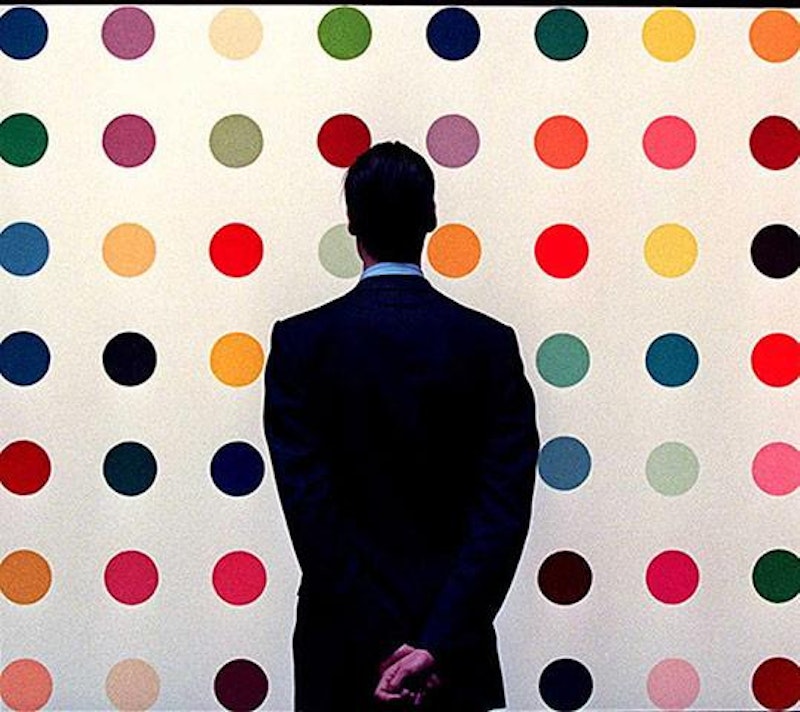Few contemporary artists know how to unleash the magic of hype better than the conceptual art star Damien Hirst, the UK’s wealthiest living artist. This is someone who many would say is both overrated and not all that talented. What’s so original about a shark floating in a tank of formaldehyde? But those statements are a waste of time and miss the point. You can’t deny that over the years, Hirst has masterfully used the space of art to create headline-grabbing publicity stunts that make even Lady Gaga’s impressive press stunts seem like a student craft project. In 2007 Hirst orchestrated an all out media frenzy with “For the Love of God,” a real human skull encrusted with 8601 diamonds—how decadent. But the frenzy had less to do with the diamonds themselves than it did with the news that an “anonymous” investment group “purchased” it for $100 million dollars. One thing’s for sure: whoever bought it is now privy to a (some!) very expensive head.
In this case, the intervention was never just about the skull itself, as it goes with conceptual art which is more interested in systems, institutions, and processes than it is in objects. The Hirst skull was about the way the story of its sale penetrated international news cycles, which in turn was a commentary on the interconnectivity between celebrity, corporate culture, money, publicity, auctions, not to mention the art world, a learned, pearl-necklace-wearing, hedge-funded place that’s supposed to be immune to the gaud and anti-intellectualism of publicity. During a story in Interview magazine, Hirst told Anthony Haden-Guest that in his works, money “is an ingredient, I think, in the composition. Especially money. Or power. And all of those things.”
Now, Hirst is at it again with “The Complete Spot Paintings: 1986-2011,” a simultaneous, international exhibition currently on show at Gagosian, the high-end, New York-based contemporary art gallery with a global footprint. The “Spot” paintings are part of a cycle of works begun in 1986, and though as many as 1500 “Spot” paintings currently exist, they are intended to be an endless cycle. The thing is, “The Complete Spot Paintings” shows 331 spot works throughout all 11 Gagosian galleries all over the world, all at the same time, right now. So if you’re in New York, you can see a total of 115 different “Spot” paintings if you visit the three Gagosian outposts in the city, or go to London, Paris, Los Angeles, Rome, Athens, Geneva or Hong Kong if you want to see you some spots! But what’s the fuss with the spots? The “Spot” paintings—or the dots, as I call them—are exactly that: whole canvasses filled rigorously, entirely, yet seemingly randomly, with a grid of dots. As a series, they are meticulous explorations of color, because no single color repeats twice. Importantly, Hirst doesn’t make the dot paintings himself—and he hasn’t made one on his own since 1993. They are produced (that’s the key word) by an elaborate system of assistants, making Damien Hirst the brand name in front of the labor of more than 100 employees, and brings him closer to other industrial fields, like how an architect designs a building but doesn’t build it, or where a couturier designs a fashion collection but doesn’t sew it. Made by humans, the dots look machine made.
It’s kind of bewildering to stare into a painting with 25,781 dots on it. At a cursory, first glance, as art they’re hard to like, philosophize, or even “read” as objects because they are… a bunch of dots on a big white canvas. And yet, the feeling you get when you see them live, or what I felt anyway, is happiness. In the 24th St. Gagosian outpost, where I first saw the dots, the huge ceilings in the industrial space seemed like barely enough room for the enormous, floor-to-ceiling sized paintings. When I spun around the room I felt happy, joyous, and I could tell that other people did, too. “They look like Legos,” one person said. Everybody likes dots! Dots are cute, fun. They’re mesmerizing, and believe me, staring into the abyss of 26,000 dots can make you a more than a little woozy. And if you think gazing cross-eyed at a canvas with 26,000 dots on it is trippy, just wait until Hirst releases the 9 foot by 6 foot version with 1 million dots.
And there’s the catch, because with Hirst there’s always a catch: the official title for the dots is the “Pharmaceutical Paintings.” Each work typically refers to mild hallucinogens, and this is frequently reflected in the individual titles of the works, like the Controlled Substance Key Painting from 1994, LSD from 2000, or Phenyltoloxamine if you would really like to get scientific. So, is the commentary here about the role of drugs and other substances in manipulating happiness? In hiding drugs in the works—a fact most people would miss if they didn’t look at the titles—is Hirst implicating us all in the pleasures that hallucinogens provide?
The publicity stunt to simultaneously exhibit 331 dot paintings in 11 cities all over the world is brilliant because, in this age of “corporations are people” rhetoric, it frames Hirst as a multinational corporation through an already corporate, international gallery. Right now, DAMIEN HIRST, the corporation, has business outposts in all the world cities. Art is not supposed to be corporate, we’re told, even as an “investment firm” “bought” the diamond skull for $100 million. And it’s not enough that the dots are already corporate artworks, because they’re easy and the “right” kind of art to have (a “Damien Hirst”), yet they don’t demand much because they can be seen and understood in seconds. And in the seconds it takes to perceive a Damien Hirst in your office center—pow—status has already been assured. Through a circular logic, the “spot” paintings participate in the systems of publicity, status, and corporate culture they work to critique.

